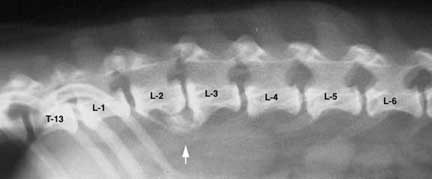Laurie's Blogs.
Mar 2017
Spondylosis in a Young Agility Dog

A few days ago, I saw a 3 year old intact female border collie with a 2 week history of rear end weakness after heavy work. On exam, I could not elicit pain anywhere, but did find a subtle weakness on the right rear. I did some acupuncture and laser. The following day reg vet did rads and bloodwork. Anaplasma positive, but also spondylosis of T12-13, L1-2, L2-3. I'm suspecting (hoping) the symptoms were related to the anaplasma, but I am concerned about the presence of spondylosis in such a young dog. The owner is a vet tech and knowledgeable about conditioning, proper warm ups, avoids ball retrieves, etc. The dog goes on off lead woods walks several times per week, and is in great body condition. There are several other dogs in the household, but from what I understand, they don't have overly rough play. This is an active dog, but not over the top like some BC's can be.
Any thoughts about why such a young fit dog would be developing spondylosis? And ideas on preventing further progression? My thought is core work, but I'm certain that's already being done.
JW
----
Hi JW!
Okay... so my thoughts about spondylosis. It's a topic I bring up in my Manual Therapy for the Canine Spine courses all the time!
So, the thoracolumbar junction is a transition zone in regards to freedom of movement and what the shape of the facet joints will allow. The thoracic spine has horizontal facets, which allow freedom of movement into flexion, extension, side bending, and rotation... save for the ribs and ligamentous support to moderate mobility, it's a 'party all the time' up there! From T11 caudally, the facets are more vertically oriented, and there are also accessory processes down to L3/4 which limit motion to flexion & extension (primarily). You can get some degrees of side bend & rotation if the spine is flexed, but otherwise, that's not what the joints are built to allow.
Here's the issue: In any transition zone, there is an imperfect transference of load from one area to another and those guys (i.e. the facets in this case) in the transition zone take a bashing. This can cause remodelling of the facets. What has been observed (research of Breit, Knaus, & Kunzel), is that with exaggerated or repetitive loading into extension or ventrally, the facets will extend themselves and create caudal and ventral facet joint extensions. When you have facet joints not only medio-laterally, but also caudally, and ventrally, you end up with a type of 'ball and socket joint'. In this scenario, the spine has a significant reduction in stability. Muscles and ligaments are what is left to stabilize... but as you know, a dog can exert a ton of force and motion through the spine with running, jumping, playing etc. So, MY THEORY, is that the NEXT things that occurs is spondylosis as a way for the body to stabilize the joints.
As far as border collies go, I am more surprised NOT to see spondylosis in a dog over the age of 8. When the condition started to occur, I don't know, but maybe 3 is not crazy at all! We start to see degeneration, etc in human spines as early as our 20's... so 3 in a border collie might not be alarming. How many 3-year old border collies get x-rayed?
So, you might not be able to stop further progression... what I would want to stop is degeneration of the discs at sites adjacent to the spondylosis, and at the lumbosacral junction in particular. My best suggestion would be routine traction of the back - standing one-man traction and tail pulls. From a therapy perspective, I would recommend a maintenance regimen of other manual therapies (mobilizations, myofascial release, & massage), acupuncture, and laser for the spine. It sounds like the dog likely already has a great core. Test it with the rear leg slide test (look for a drop of the pelvis) to see if the motor control & timing is off, and treat that if you find it to be problematic. See this video:
All in all, I'd tell the owner not to panic. You have a rationale and now a plan!
I hope this helps!
Cheers,
Laurie
PS
Members can watch Video Training 13 & 16 for instruction on traction & motor control & timing.


